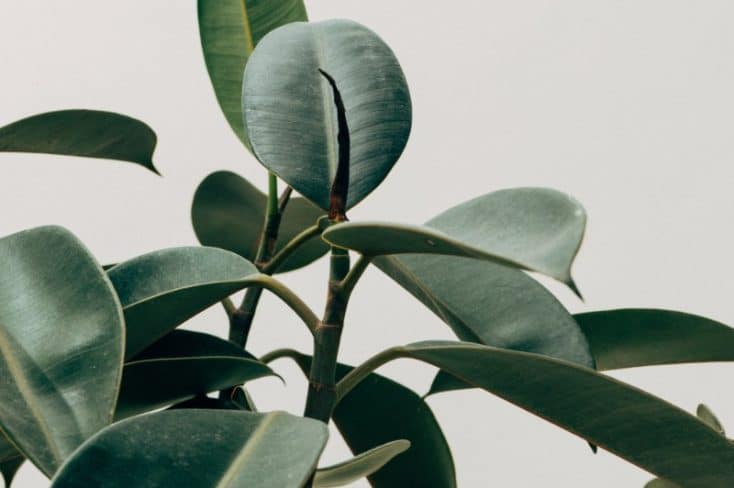If you’re looking for a houseplant that makes a bold statement, then look no further than a Rubber Plant (Ficus elastica), also called Indian Rubber Tree. With their ease of care, these are perfect indoor plants for beginners or those who consider themselves having a black thumb. Lets start with a quick summary of rubber plant care, with additional details following.
How To Care For A Rubber Plant (Ficus elastica): Grow your Rubber Plant in soil that drains well, create moderate humidity and keep temperatures between 50°F (10°C) to 85°F (29°C). Water when the top inch of soil becomes dry and fertilize monthly.
Continue reading because we remove any mystery about growing and caring for your Rubber Plant and keeping it a thriving houseplant for years to come.
How To Care For A Rubber Plant
Rubber Plants belong in the large genus of Ficus, which include around 900 different species of trees, vines and shrubs, and is broken down even further with the vast amount of different cultivars for each of the species. Rubber plants are no different and include different varieties (cultivars) that differ primarily in the coloration of the foliage.
All varieties of Rubber Plants are considered broadleaf evergreens, with large, thick, leathery foliage. Their native range is from the Himalayas to Sumatra, Malaysia and Java.
Due to their popularity and ease of growth, you can now find Rubber Plants growing outdoors throughout frost-free locations of the world. In addition, they make hardy and carefree houseplant for those living in locations too cold for outdoor growth.
When grown outdoors in its preferred climate, Rubber Plants can obtain a mature height of 100 feet with the same spread. Don’t despair, because even when grown indoors it can achieve a height of 10 feet and with a similar spread, if left unpruned and grown in preferred conditions. Like the majority of species in the Ficus family, Rubber Plants have a moderately fast rate of growth.
These are attractive indoor trees that make an eye-catching statement, with their large, glossy leaves ranging around a foot long and 5 inches across. The standard Rubber Plant’s leaves are solid green, but you also have choices in the various cultivars that pump up the color on the foliage. Some of the various varieties of Rubber Plants include:
- ‘Decora’ – Has dark green foliage with a white midrib.
- ‘Rubra’ – Has dark green foliage with a red midrib.
- ‘Tricolor’ – Has green leaves with patches of pink and cream.
- ‘Robusta’ – Produces larger green leaves that grow around 18 inches long.
- ‘Doescheri’ – Produces variegated leaves in gray and cream with pink ribs.
- ‘Variegata’ – Produces smaller leaves variegated in yellow and green.
- ‘Foliis Aureo-marginata’ – Has gold margined leaves.
We’ve outlined all the tips below on their proper care and indoor growing conditions, as well as identifying and preventing potential problems before they occur. A healthy and happy Rubber Plant will grace your indoor spaces for years to come. Even those who believe they kill everything should have success growing a Rubber Plant.
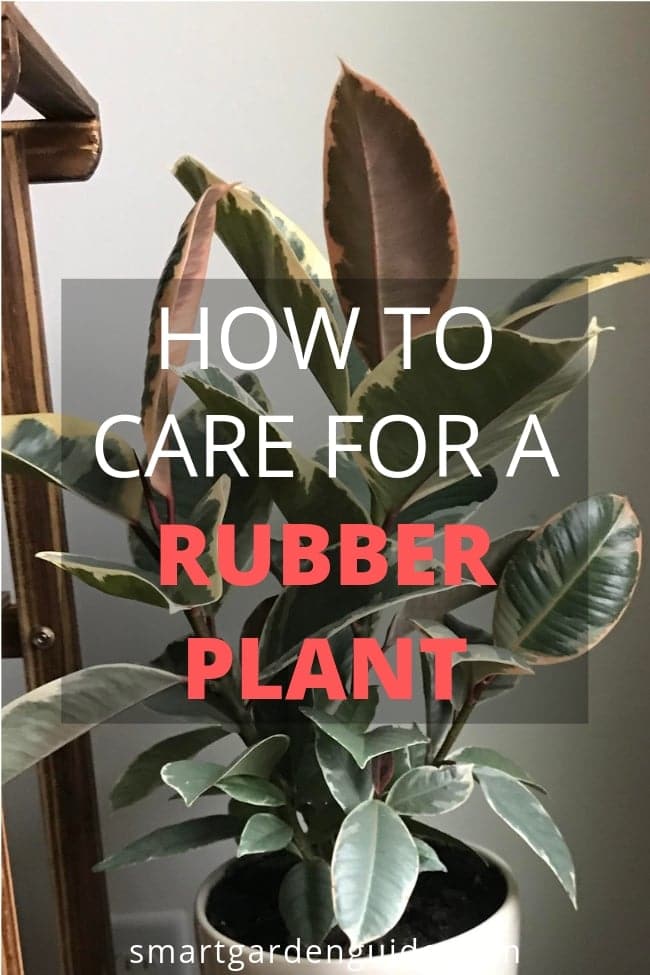
Soil Conditions For Your Rubber Plant
Rubber Plants tolerate a wide range of soil conditions provided they drain well. However, since you are growing the plant inside a container you’ll want to get it off the best start possible by planting it in a good soil mix with fertility.
You won’t want to use a straight potting soil because it has a tendency to be too heavy and retains too much moisture, which can lead to problems with root rot. However, if you cut the potting soil with another medium like a potting mix, or peat, and only have around 50 percent of the soil straight potting soil, you should lighten up the soil enough so it drains well.
Otherwise, your best option is to use a fertile potting mix because it drains and won’t retain too much water. Many types of potting mixes also contain slow-release fertilizers, which also help feed the Rubber Plant, which helps if you forget to fertilize.
You can also make your own soil mixture by using equal portions of peat, pine bark and coarse sand.
The biggest things to remember to keep your Rubber Plant growing at its best is to make sure the soil has some fertility and drains well.
How Much Light Does A Rubber Plant Need?
When it comes to preferred light conditions for the best growth, where you place your Rubber Plant depends on what type you are growing. Those with solid green leaves can take lower indoor light conditions than variegated types.
To keep the colors at their best, place variegated Rubber Plants in a location that receives bright, indirect light. Placing it in a location with low light conditions will make the plant lose some of the color on its foliage.
Green types also tolerate bright, indirect light conditions indoors, but will also tolerate areas where the light is a bit lower. Whatever you do, don’t place either the green types or variegated types in a location where it receives direct sunlight or the leaves can become sunburned.
Rubber Plants growing in light conditions that are too low have a tendency to produce spindly growth. To remedy the situation, move the plant to an area receiving a bit more light.
If you decide to give your Rubber Plant a break from indoor conditions once the weather warms in springtime, place it in a location receiving partial sun to partial shade. If outdoor light conditions are too sunny, the foliage will end up burned.
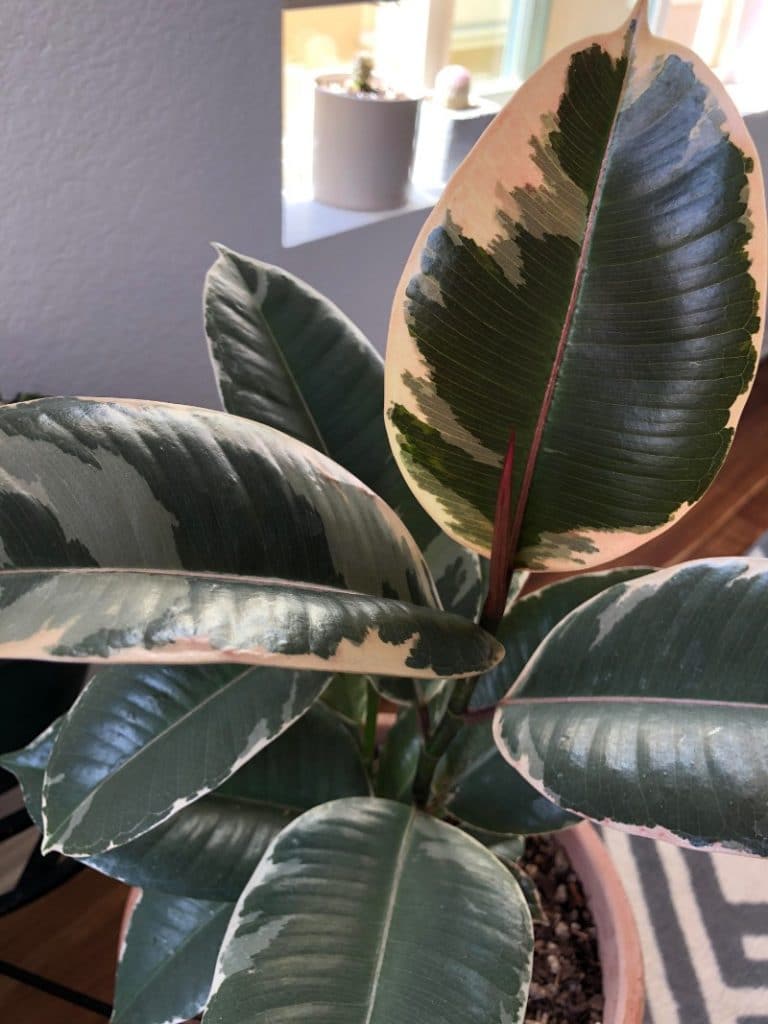
Rubber Plant Temperature Requirements
When it comes to a Rubber Plant’s preferred indoor temperature, remember, it’s native to tropical regions of the world that remain frost-free throughout the year. To keep the plant happy and growing well, keep indoor temperatures between 50°F (10°C) to 85°F (29°C), although it will tolerate indoor temperatures as low as 39°F (4°C).
A good rule of thumb to follow when it comes to prime indoor temperatures for your Rubber Plant is if it’s comfortable for you, it’s comfortable for your Rubber Plant.
If you are growing the Rubber Plant outdoors while the temperatures are warm, remember to bring it indoors before Frosty the Snowman pays his visit in winter. Otherwise, you’ll end up with a frost damaged Rubber Plant and if outdoor temperatures are too cold, it might result in the plant’s death.
Water Requirements
To keep your Rubber Plant performing at its peak, make sure to soak the roots thoroughly when you water. This calls for watering until you see it coming out of the bottom of the pot’s drain holes. However, you don’t want to let it sit in water for too long or you might end up with problems with root rot. After about 30 minutes, empty the bottom tray of any water that’s accumulated.
During the growing season, you’ll probably have to water the Rubber Plant once weekly. Knowing when to water is easy:
- Stick your finger into the soil mix and if the top inch of soil feels dry to the touch, apply water.
However, in winter when the Rubber Plant goes dormant (growth slows), you’ll probably only have to water every other week. Once again, stick your finger into the soil and if the top inch feels dry, apply water until it runs from the bottom drain holes.
For the best results, use room temperature water that’s been allowed to sit out overnight. You can also use rainwater to water your Rubber Plant.
If you start noticing the foliage starting to yellow, the plant isn’t probably getting enough water.
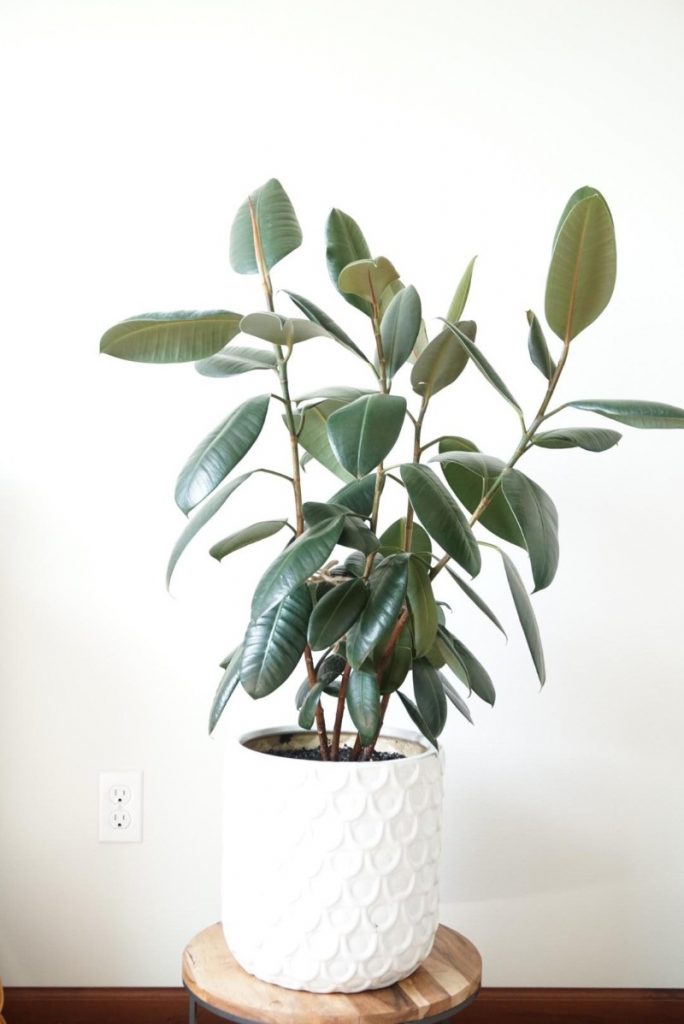
Humidity Needs
In their native environment, Rubber Plants grow in areas where humidity is a constant. Therefore, to keep your plant producing healthy growth and preventing potential problems, it’s imperative you replicate humidity while it’s growing indoors.
In addition, don’t place the Rubber Plant in an indoor location where the air is naturally dry like near a heating or air vent.
No need to stress because creating humidity for your Rubber Plant indoors is relatively basic and you have a variety of options:
- Fill a spray bottle up with water and mist the foliage several times each week. You cannot mist too much, so if you spray the leaves daily the Rubber Plant won’t suffer problems.
- You can fill a large tray with small pebbles and sit the container on top of it. This lifts the container out of the water and the moisture in the rocks help create humidity around the Rubber Plant.
- If you have a large bathroom that receives adequate light conditions, you can situate the Rubber Plant there. With the constant running of water through showering and such, an adequate amount of humidity is naturally created for the plant.
How To Fertilize A Rubber Plant
Rubber Plants’ aren’t big eaters when it comes to fertilization, but regular applications of fertilizer throughout the growing season keeps the plant producing those big, glossy leaves and helps maintains its health.
You only want to fertilize your Rubber Plant while it’s actively growing, which is generally spring throughout summer. Once winter strikes, the plant goes into dormancy and growth slows, so you should cease any applications of fertilizer.
During the growing season, you can apply a water-soluble fertilizer when you water. You’ll only need to fertilize monthly to keep the Rubber Tree happy and healthy.
When it comes to what to use, you have several options that will work well.
- You can use slow-release granules, sprinkling them on top of the container’s soil, and you’ll only have to fertilize every couple of months. Slow-release fertilizer slowly breaks down into the soil each time you water and most products last anywhere from two to three months before you need to reapply. Always follow the particular product’s recommended amounts and frequency of application.
- You can use a water-soluble, houseplant blend, applied at half-strength. Just mix the product into your watering can and apply as you normally would when just watering.
- A balanced water-soluble blend for both indoor and outdoor plants is also suitable to use. Mix at half-strength and apply when you water the Rubber Plant.
Fertilizers have a tendency to build up salts in the soil over time, so you will need to flush the soil periodically to remove them. Although Rubber Plants have a moderate tolerance to salty conditions in the environment, too much salt in the soil can cause burning of the foliage.
Removing salt buildup is easy. Depending on the size of the Rubber Plant, you can either take the entire container to your kitchen sink or bathtub, or take it outdoors to do the flush, if the plant is too big to handle indoors. Allow the water to run gently through the soil flushing out the salts for approximately five minutes. Let the water drain from the bottom and once it’s finished draining, place back in its indoor location.
Pruning Requirements
When cut, Rubber Plants exude a milky white sap, which some people find irritating to their skin. If you aren’t sure how your skin will react to the sap, it’s probably a good idea to wear protective gardening gloves when pruning. You also don’t want to get the sap in your eyes, as it will irritate them too.
If your Rubber Plant is still small, averaging only several feet in height, there’s no need to prune. However, once it obtains the height you’d like to keep it at, you can prune off the top branches. Hand pruners will generally do the job for indoor Rubber Plants, but if the branches are too thick, use loppers.
To help you Rubber Plant branch out and grow fuller, you can prune off the side branches. Every branch you prune, several new branches will grow, leading to a fuller plant.
Since the plant goes into dormancy through the winter months and doesn’t start putting on new growth until the weather warms in spring, there’s no need to prune during the cooler months of the year. However, pruning off branches anytime of the year won’t hurt the Rubber Plant if you need to do some shaping. It’s also fine to clip off any dead, damaged or diseased leaves as they appear.
In addition, you don’twant to transfer any diseases or pests to your Rubber Plant, so always use clean pruning tools to make your cuts. You don’t have to do anything elaborate to clean them and just wiping the blades off with alcohol does the trick.
Potting And Repotting Needs
Your Rubber Plant should grow well inside a 3-gallon container for several years before it’s necessary to repot. If you’ve just brought your plant home from the garden center and it’s only growing inside a 1-gallon container, and it’s on the verge of being top heavy, you might want to go ahead and repot into a slightly larger container.
This alleviates the need to have to repot the Rubber Plant in a couple of months. Always repot into a container that is slightly larger than the original one. Planting in a pot too large can have the soil remaining too wet, which can lead to health problems.
You also don’t want the Rubber Plant’s roots to outgrow the container, as it can impede good growth in the future. Plants that have been left to grow in containers that are too small develop intensive root wrapping and might never grow to their full potential, even when transplanted into a larger pot. Many times, roots will grow out of the container’s bottom drain holes when they’ve outgrown their present container.
Any type of container works well, as long as there is drainage in the bottom. You can set the pot with drain holes into a more decorative pot without drain holes, but be sure to empty any water from it after watering or root rot can occur.
I love picking really beautiful planters for my houseplants to ensure they take pride of place in my home and look amazing. Check out my best recommendations for planters here.
For a lower maintenance option, self watering planters are great, and rubber plants can grow well in them. Here are some good options for self watering planters that I have used with good success in my home.
The process of potting or repotting your Rubber Plant is relatively basic and you don’t need to be a rocket scientist to do it correctly.
- Gently remove the Rubber Plant from the container it’s growing in and carefully tease the roots apart if they want to start wrapping.
- Fill the new container up about a quarter of the way full with a fertile, well-drained potting mix.
- Place the Rubber Plant into the new container and fill the remainder of the way up with soil. Make sure you don’t plant it any deeper than it was originally growing in its original pot. Firm the soil around the base of the plant using your hands.
- After planting, water the Rubber Plant to saturate the root system. Water until it runs from the bottom drain holes.
- Place the Rubber Plant in a location indoors that receives bright, indirect light.
Just remember to use a slightly larger pot that drains and filled with a rich soil mix that drains well and doesn’t have a tendency to remain too wet.
Propagating New Plants
You can propagate additional plants from your Rubber Plant while it’s actively growing through the warm months of spring throughout summer. The propagation steps are basic and even those with black thumbs should have success.
- Using clean pruning tools snip off about a 4- to 6-inch section from the end of a branch.
- Snip off all the leaves other than the top one or two. This allows the cutting to put its energy into forming new roots and not into developing new leaves.
- Since the cut section will exude its milky sap, allow the cutting to rest for about 30 minutes before potting.
- Fill a 6-inch to 1-gallon container that has bottom drain holes with a lightweight potting mix, or seed-starting mixture. Water the soil in the container so it settles.
- Make a several inch indentation in the center of the pot where the end of the cutting will be inserted.
- Before planting the Rubber Plant cutting, dip the cut end in a rooting hormone.
- Place the cut end treated with the hormone into the center hole and firm the soil around it using your fingers.
- Water the soil again and until it runs from the bottom drain holes. Keep the soil moist but not soggy while the cutting develops roots.
- Place the container in an indoor location that receives bright, indirect sunlight.
It generally takes around four to six weeks for the Rubber Plant cutting to start developing roots. After three to four months, it should have a good root system developed. If you touch the cutting, it should stand firmly in the soil, if it’s developed a root system.
Cleaning The Leaves
Many times with regular misting your Rubber Plant’s leaves will remain clean, as the water washes off any dirt or dust. However, if you find those big leaves starting to get a bit dirty looking, you can easily dampen a soft cloth and wipe them off. There are products on the market designed specifically for foliage cleaning, but I wouldn’t recommend any of them, as plain old water and a cloth works well and is best for your plant.
I’ve got a few tips and tricks for cleaning the leaves of your houseplants which can help you clean your plants with ease, while keeping your plants in the best of health.
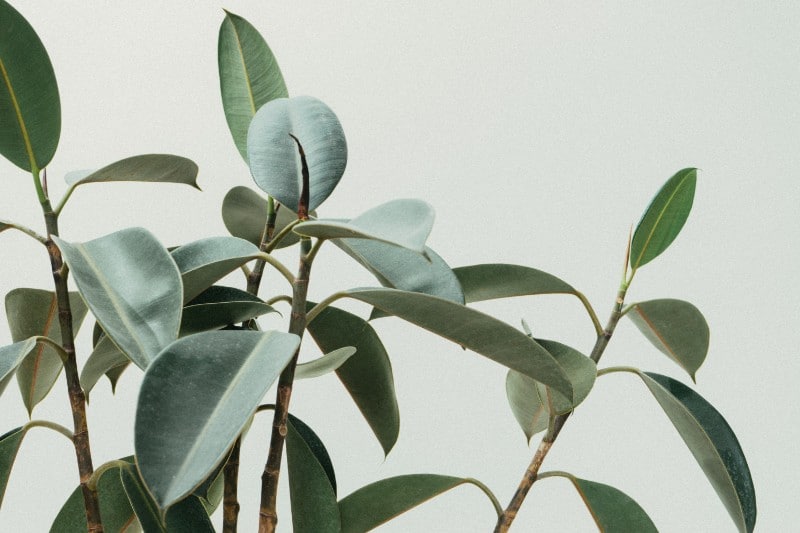
Pest And Disease Problems
When grown indoors, Rubber Plants are relatively pest- and disease-free. The biggest disease threat is root rot, which is caused by overwatering and the soil remaining too wet for too long due to heavy soils that don’t drain properly, or planting in a pot that is too big for the plant.
Rot usually shows up with the foliage turning black and the stems and foliage suddenly drooping. In severe cases of rot, there’s not much you can do except discard the entire Rubber Plant. However, if the problem is just showing up, you can possibly save the plant.
- Remove the entire Rubber Plant from its container and inspect the roots.
- Using sterilized pruning tools, trim away any roots that are rotted or look damaged.
- Repot in new, clean soil that drains well, and only water when the top inch of soil becomes dry.
Indoors, the pests listed below may bother Rubber Plants:
- Spider Mites: It’s easy to diagnose a spider mite problem as the tiny pinhead-sized mites spin webbing that covers the Rubber Plant’s leaves. The mites suck the plant’s juices and if left uncontrolled can eventually kill the plant and infest your other indoor plants.
- Mealybugs: Mealybugs also suck the plant’s juices and show up as cottony masses along the branches and leaves. They too can eventually kill the Rubber Plant and infest your other indoor plants if the problem isn’t controlled.
To treat the pest problems, as soon as you notice the insects on your Rubber Plant, spray the entire plant with an insecticidal soap or Neem oil, making sure to get both sides of the leaves. Reapply as recommended on the product label.
How Often Do You Water A Rubber Plant?
It’s easy to check when to water your Rubber Plant by sticking your finger into the soil and if the top inch feels dry, apply water until it runs from the bottom drain holes. During the growing season of spring through summer, you’ll probably water weekly. However, in winter, you should cut back watering to about once every two weeks.
Do Rubber Trees Need Direct Sunlight?
Rubber Trees grown as houseplants should receive no brighter light than bright, indirect light as the foliage may burn. However, variegated types need more light for their foliage to retain their mix of colors and solid green varieties tolerate lower light conditions.
Why Are The Leaves Falling Off My Rubber Tree Plant?
Leaf drop can be caused by several environmental conditions. If the plant is being overwatered, the foliage can drop. In addition, if the indoor temperatures are too cold and the Rubber Plant is in a drafty area, the foliage will also drop. Only water when the top inch of soil becomes dry and move the plant out of the drafty area and where temperatures remain above 50°F (10°C).
Why Is My Rubber Plant Leggy?
Rubber Plants not getting adequate light will become leggy. Move the plant to brighter conditions and prune the branches back so they will branch out and becomes fuller. Make sure to use clean pruning tools so you don’t transfer pests or diseases to the plant.
Why Are My Rubber Plant’s Leaves Curling?
Several things cause leaf curing in a Rubber Plant. If you are overwatering or under-watering, the leaves may curl. Water when the top inch of soil becomes dry and until it runs from the bottom drain holes. Too dry air may also cause leaf curling due to lack of humidity. Move the Rubber Plant away from any heating or air vents and mist the plant with water several times weekly to increase humidity.
Are Rubber Plants Toxic to Pets And People?
Keep out of reach of pets and children, as all portions of the Rubber Plant are toxic due to psoralen and proteolytic enzyme ficin. If you’re looking for some fantastic non-toxic indoor plant options, I’ve written an article about 17 of my favorite non-toxic houseplants.
Does Rubber Come From A Rubber Plant?
In the early 1900s an inferior rubber product was made from the Rubber Plant (Ficus elastica), but the primary source of natural rubber today comes from the Para Rubber Tree (Hevea brasilienses), which belongs in a different family.
Do Rubber Trees Bloom Or Produce Fruit?
Rubber Trees grown outdoors in their native habitat produce small, green fruits but don’t fruit growing indoors as a houseplant.
If you want to keep your houseplants healthy and thriving, check out my resource page, where I share my recommendations for all the resources, tools and equipment you will need to grow houseplants that bring happiness and beauty into your home.
I really love the large, vibrant and beautiful foliage of rubber plants and think they are an excellent option for almost everyone. If you’ve been inspired to add a rubber plant to your home, head over to Amazon and get a rubber plant now.

